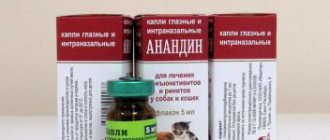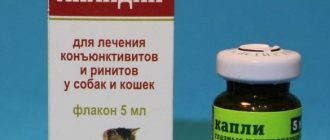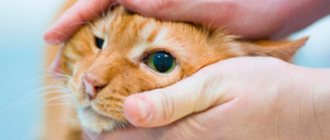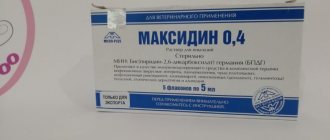- infectious inflammation of the organs of vision;
glaucoma and cataracts (for corticosteroid drugs);
When using drops for long-term treatment, it is recommended to abandon contact lenses for the duration of therapy, replacing them with glasses for this time.
If, at first glance, there are no contraindications, but when instilled the patient experiences side effects, the use of such drugs should be abandoned, even if, along with improvement, the discomfort and pain intensify.
Possible causes of purulent discharge
Choosing the right treatment depends on the nature of the problem and the factors that caused it. Among the most likely:
- Eye injuries in cats. This often happens in fights or games, during unsuccessful jumps and other accidents. Then purulent inflammation may develop in the damaged area.
- Entry of foreign objects. Theoretically, any foreign speck can stick to the cornea, get stuck in the conjunctiva and lead to irritation and infection.
- Allergic reactions. Although they are not accompanied by suppuration, the resulting itching of the eyes contributes well to the entry and attachment of bacteria that cause purulent processes. If we talk about the causes of allergies in pets, it can be caused by certain foods, fumes from household chemicals, dust and cigarette smoke, mold particles and insect secretions.
- Conjunctivitis. In cats, they are divided depending on the causes, similar to eye inflammation in humans. That is, they can be caused by viruses, fungi, and pathogenic bacteria. Abundant purulent discharge is often colored yellow and greenish. If the eyes are severely damaged, a pinkish color may appear due to blood impurities. All this leads to a painful state for the pet.
- Keratitis is just as painful. Inflammation of the cornea often begins after injuries and burns, but the causes can also be physiological.
- Complications in the eyes after infections of other internal organs.
It is important to know that with diseases both eyes fester. In case of injury and debris, only one. Colds can be distinguished by the fact that rotting eyes are accompanied by a runny nose. Acute gastrointestinal infections occur with vomiting and intestinal disorders. When other organs are affected, fever often occurs. But even without this, the animal feels great discomfort from bright light, loses appetite and constantly rubs its eyes with its paws.
What types of eye drops are there for cats and kittens?
Vet pharmacies always have several different drugs in stock. The most popular and effective ones can quickly help with eye inflammation due to simple diseases or injury:
- Ciprovet contains a modern antibiotic. According to the instructions, it is also used to treat kittens. Ciprofloxacin, which is part of it, is able to cope with staphylococcal infections and is effective in the treatment of chlamydia.
- "Diamond Eyes" Contains chlorhexidine and is active against various bacterial flora. Most often used to treat the area around the eyes for diseases and to care for rare breeds of cats. The composition also includes active ingredients such as succinic acid and taurine, which are beneficial for the eyes.
- Levomycetin. Antibiotic, effective against staphylococcal infections, often prescribed to treat conjunctivitis.
- "Bars" (ophthalmic drops). Contains novocaine and furatsilin, has an analgesic and disinfectant effect. Suitable for kittens and adult cats with various bacterial infections.
Removing Foreign Objects
Most often, upon examination, it is possible to notice a speck in the eye. If you can’t hook it with your fingers or tweezers, and the animal strongly resists, you should act differently by dripping Furacilin dissolved in water, saline solution, or simply boiled water and cooled to room temperature, previously slightly salted, into the inflamed eye.
The cat will begin to blink and help itself with its paws. This way the speck can come out along with the fluid flowing from the eye. Instillation or rinsing with a moistened swab should be repeated until the foreign body leaves the eye.
How to put drops in a cat's eyes
Dropping medicine into your cat's eyes is quite simple. The pet is picked up and soothed by stroking. Then the cat is placed on its knees with its back down, the paws are fixed by an assistant, but you can carefully wrap it in thick fabric, leaving only the head outside.
The eyes are cleansed of pus and other secretions using cleansing lotions and drops (Cliny, YUGI, EYE Cleaner, etc.). To do this, they are dropped into the eyes and then removed with a cotton swab or gauze.
The lower eyelid is carefully pulled down, and with the other hand the required number of drops is applied to the mucous membrane. After treatment, the pet must be held in your arms to prevent it from scratching its eyes.
IMPORTANT! Any eye treatment is carried out in the direction from the outer corner to the nose. Thanks to this, the discharge will not remain on the mucous membrane.
Home treatment for eye infections
When a cat refuses its favorite food due to purulent discharge from the eyes, one can safely suspect acute inflammation. Most likely, it is infectious in nature and caused by bacteria. In this case, you need to apply antiseptics externally in the form of:
- Washing. For them, solutions and liquids with antibiotic properties are used: the same Furacilin, weakly diluted potassium permanganate, infusions of calendula or chamomile flowers, oak bark decoction, three percent peroxide or Chlohexidine. 3-4 times throughout the day, soak a tampon in one of the listed liquids and wipe your eyes. All solutions must be fresh, especially herbal infusions.
- Burying. Ready-made medications with antibiotic drops should be recommended by a veterinarian. However, in critical situations, you can use drops with Levomycetin Albucid, Tsiprolet, Sulfacetomide at home. Anandin relieves itching, minimizes swelling, and eliminates inflammatory redness. All drugs are used according to their instructions. The usual dosage for a cat is 1 - 2 drops in each eye up to 3 times a day.
- Mazey. This is usually Tetracycline eye ointment. You need to keep your pet's head immobilized, gently rubbing a small amount of the composition, previously placed on the drawn eyelid, twice a day.
Rules of application
Rules of use and recommended dosages are contained in the instructions for each drug for the treatment of eye diseases in cats. There are also general recommendations that must be followed when trying to help your pet on your own:
- before using the drug, you need to make sure that it is intended for animals and has antibacterial properties, and its shelf life has not yet expired;
- Before putting drops into the cat’s eyes, you need to use a swab moistened with warm water to remove crusts and accumulations of mucus on the eyelids and around;
- make sure that the animal is securely restrained and does not jerk its head, causing injury to itself on the dropper spout.
Eye allergies
It is usually indicated by small purulent drops in the corners of the eyes. But in order for the treatment to be effective, you need to understand which allergen led your pet to this condition. If you do not avoid contact with the irritating substance, your pet's immune system will not recover completely.
You can relieve unpleasant and painful symptoms by washing the eyes and instilling antihistamine drops purchased at a veterinary pharmacy. If home treatment does not produce noticeable results for several days or the pet becomes worse, you should immediately take the cat to a veterinary clinic. You can’t take risks, because the animal may have a dangerous disease that leads to blindness.
Preventing vision problems in cats
Cats are famous for their excellent vision in the dark. Of course, visual acuity depends on the health of the eyes. Unfortunately, cats are often susceptible to eye diseases, which can lead not only to deterioration, but also to complete loss of vision. To avoid such disastrous consequences, first of all you need to use special drops for preventive purposes. The best options are lotions based on medicinal plants - chamomile, St. John's wort, sage, calendula, and green tea. You can use special washing solutions such as Beaphar Oftal or Ofto-lavas. These are sterile liquids that should be used to clean the eyes of animals twice a week.
What solution should you wash your eyes with?
It is important not only to know how to properly clean a cat’s eyeball of pus, but also what solution is allowed to do this. If you notice inflamed eyes, the right decision would be to contact a veterinarian
He will advise you on what solution you can use to clean your cat’s eyes. The veterinarian will take a swab from the conjunctiva for analysis and accurately determine the cause of inflammation and pus formation. Usually he prescribes:
- Furacilin solution has an excellent antibacterial effect. You can buy a ready-made solution, or you can prepare it yourself. Take two tablets of furatsilin per glass of warm boiled water, crush to a powder, bring to complete dissolution by constant stirring. Before dripping into the cat's eyeball, you need to strain it through double gauze so that the medication particles do not damage the mucous membrane.
- A solution of boric acid is prepared as follows: take one teaspoon of boric acid per glass of boiled water and stir thoroughly until completely dissolved.
- A saline solution is good for removing foreign particles and dirt.
- Diamond Eyes drops have a good effect.
If the kitten shows pus that irritates the pet, the veterinarian will often prescribe the following medications:
- Tetracycline eye ointment.
- Hydrocortisone eye ointment.
- Levomycetin powder.
- Tsiprovet.
- Iris.
It is not recommended to use ointment with antibiotics and hormonal agents without a veterinarian's prescription.
Folk remedies
If there are no medications and you need urgent help, then you can use home remedies:
- Medical chamomile decoction. To prepare the decoction, take 2 teaspoons of the mixture, purchased at a pharmacy, in 60 milliliters of boiling water, leave for 5 minutes. Before use, strain through double gauze.
- The tea solution not only cleanses of foreign particles, but also acts as an antiseptic. You cannot use freshly brewed tea. Yesterday's tea leaves work well, but it is strictly forbidden to use two-day-old tea leaves, because bacteria begin to multiply in it.
- A solution of potassium permanganate is used to clean the eyeball. The medicinal solution should have a slightly pinkish color without the presence of undissolved crystals. Otherwise, it threatens to burn the mucous membrane.
Most kittens have problems with their eyes. With the right approach, the owner can deal with this problem quite easily; the main rule is not to delay cleaning the eyeballs. If eye inflammation does not go away, then it is advisable to consult a veterinarian.
Causes of conjunctivitis in cats
The reasons are very varied:
- mechanical injuries and wounds, ingress of dirt;
- household chemicals with a strong odor (paints, aerosols, deodorants);
- infectious diseases of cats (viral rhinotracheitis, calicivirus, chlamydia);
- penetration of parasitic worms into the eyeball;
- incorrectly selected dry food (if food intolerance to certain foods is present);
- Trichiasis of the eyelids is the pathological growth of eyelashes inside the cat's eye.
Methods for diagnosing keratitis
It is possible to select an adequate treatment for keratitis only after determining the causes of the disease. The main diagnostic tool is the slit lamp: it is used to determine the depth, extent, and localization of inflammatory foci. If a bacterial, fungal or viral nature of the disease is suspected, bacteriological and cytological studies of smears from the surface of the cornea are prescribed. A fluorescein test may be prescribed to check the integrity of the epithelium, and an allergy test to identify allergens.
Main types of disease
Any inflammation of the eyelid mucosa begins as catarrhal conjunctivitis, which can develop into a more serious form of pathology. To prevent this from happening, immediately contact your veterinarian to find out the source of the inflammation!
Catarrhal form
The least dangerous species for the animal, but requires complex treatment. Only the veterinarian determines the course! If proper measures are not taken, various complications are possible. Mucus (catarrh) is supplemented by purulent discharge from the eyes. If your animal has redness, swelling, eyelid inversion, or tearfulness, contact a specialist. To successfully treat a cat, it is important to stop the inflammation in time.
Purulent form
Yellow crusts in the morning may indicate the beginning of the process. The appearance of yellow or yellow-green pus and sticking of the eyelids already indicate a dangerous development of the disease. It could be an infection, and inflammation is a symptom. Avoid even more serious complications.
Phlegmonous form
There is discharge of pus outward and into the subepithelial layer. Treatment is very difficult even with the help of an experienced veterinarian.
Follicular form
The mucous membrane of the eyelid and the lymphatic follicles on the inside become inflamed. Protrusion is observed. Follicular conjunctivitis requires long-term therapy, and sometimes surgical removal of the follicles. After this, the cats are prescribed antibiotics and eye drops.
How is eye keratitis treated?
Keratitis is a disease with serious consequences, so treatment is often carried out in a hospital. When selecting appropriate therapy, three factors are taken into account: the cause of the disease, the severity of symptoms and the depth of damage to the cornea. Medications - primarily drops for keratitis for adult patients - are used to treat viral and bacterial types of the disease. Antiseptics are also used for epithelization on the cornea of the eye.
If deep ulcers, scars, or glaucoma form on the cornea, then surgical treatment for keratitis is necessary. Laser and microdiathermocoagulation, sclerectomy, trepanation of the sclera and other operations are used.
Here is a table that will help you choose the right eye drops and ointments for keratitis in adults.
| Type of keratitis | Drugs for treatment |
| Bacterial | Antibiotics are prescribed (Ofloxacin, Dancil, Oftaquix, Oflomelid, Levofloxacin). They are instilled in the form of drops, laid in the form of ointments. In case of serious damage to the cornea due to keratitis, injections are prescribed into the tissue around the eyeball or into the conjunctiva of the eye. |
| Viral | Antiviral drugs are used. The most popular are Florenal, Pimafucort, Zovirax, Lokoid, Acyclovir. |
| Fungal _ | Antifungal agents are prescribed - Pimafucin, Ampholip, Amphotericin B. |
| Allergic | Doctors prescribe antihistamines. Opatanol, Vizalergol, Allergodil are instilled into the eyes. Claritin, Citrine, Loratadine, Zodak, etc. are prescribed orally. |
| Traumatic | For traumatic keratitis, restorative drops and ointments are used to quickly restore the cornea, for example, Korneregel and Taurine. |
With mild keratitis and timely treatment, the infiltrates are located on the surface, so it is possible to completely restore the transparency of the cornea. In severe cases, vision may deteriorate. In any case, ophthalmologists recommend consulting a doctor at the first feeling of discomfort or pain in the eyes in order to prevent the development of dangerous diseases.











